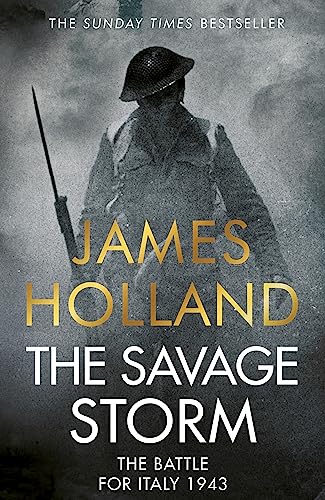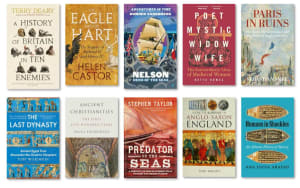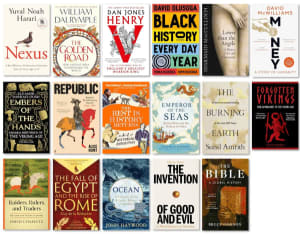This book comes highly recommended, both for Second World War history buffs and those of us who have had relatively less exposure to military history. James Holland (a Second World War expert with his own podcast) gives us an in-depth investigation into just a few months in the Battle for Italy, drawing heavily from first-hand accounts of the soldiers and civilians who lived through it. By doing so, he manages to move beyond the tactics and strategy of the battles (although there’s also plenty of that); in addition, and for me far more interesting, we get a sense of what it was like for those that lived through those battles.
Operation market share
I suspect that history books covering Second World War military history make up a large proportion of the overall history book market.1 I read on the internet that James Holland, the author of this book, and Al Murray have their own podcast specifically focused to World War Two history, which gives a sense of the extent to which this area of history forms its own distinct, but significant, sub-genre with a sizeable body of devotees who love (as most of us do) stories of derring-do and heroism in the face of impossible odds. I’ve enjoyed this type of thing in film and television, but in terms of my reading habits, I struggle to think of any Second World War history book I have ever read and, in fact, very few books on military history of any type.2 So, I came to this book as a newbie - would James Holland’s The Savage Storm convert me into a World War Two military history geek, or would I remain unconvinced?
Nice kit
On the military history geek bit first: there’s plenty here to keep this market happy. There are lots of names of armies, divisions, corps etc. Scary foreign sounding things like ‘Panzer-Aufklärungs-Abteilung’ and ‘Panzergrenadier-Division’ give a satisfying feeling that the stakes are high, and the Allies better get their act together or German compound nouns will finally achieve world domination. I expect a lot of people will love this type of thing. There’s good stuff about different types of equipment and who had the best planes. I appreciated the inclusion of all this as it made me feel I was reading a proper World War Two history book.
A human’s eye view
But thankfully, the author doesn’t get too bogged down in military technicalities. Far more prevalent are the testimonies gathered from diaries and letters about what the soldiers and civilians on or near the front line made of it all at the time. The important thing about these are they are contemporaneous (or as near as) with the events they describe. These thoughts haven’t been mediated by years of hindsight: the German soldiers haven’t been told they are fighting for the bad guys; allied soldiers didn’t know they were going to win. Nobody knew whether they would survive the war. Many had a premonition of their imminent death - which was perfectly rational, given the horrendous casualty rates.
One fact, mentioned in the book, struck me particularly: casualty rates in the Battle for Italy were higher than those for the Western Front in the First World War.
Conditions for infantry on the front lines, and the civilians caught in between, were pretty grim: waves of soldiers repeatedly advancing on impregnable mountain redoubts, mown down by machine gun fire and artillery; civilians forced by German soldiers at gunpoint to flee their homes, living in caves without clean water or food; entire villages massacred by German troops for no apparent reason (a couple of surviving children eventually waking up surrounded by dead bodies). Years later, when we know the outcome, it is easy to be sanguine about, and emotionally detached from, the Second World War. But for those living through it, it was a struggle for life and death with an unknown outcome, whether for themselves, their families, or their countries. I think that is why the Second World War continues to exert such fascination for many today.
Starring in the side show
But whilst the Western Front in the First World War has left an imprint on our collective consciousness, and Second World War battles on the Eastern Front and the D Day landings are known for their epic scale, the battle for Italy sometimes can feel like a bit of a side show. One reason for that might be that it was, strategically, for the Allies at the time, a bit of a side show – the Americans, in particular, were always much more focused on planning for Operation Overlord (the Battle for Normandy) with the campaign in Italy designed to draw German troops away from France and allow access for strategic bombing of German aircraft manufacturing sites in Southern Germany.
The problem was that for those fighting in Italy and those caught in between, it was anything but a side-show. The contemporaneous reflections of soldiers and civilians are almost always interesting and enlightening and often quite moving.3 They range from the down to earth (as in the case of the soldier who accidently fell over into a pile of human excrement), to the surprisingly reflective (soldiers on both sides noting the contrast between the beauty of their natural surroundings with the horrors of mechanised warfare).
I know a little of Italy as my girlfriend is from there – but one slightly odd consequence of reading the book is I have a newfound desire to explore more of southern mainland Italy. It sounds stunningly beautiful, and potentially quite pleasant when not full of soldiers trying to kill each other.
What does the book cover?
The book only covers part of the war in Italy. It picks up the story following the successful invasion of Sicily, and then focuses on events from the invasion of the mainland in September 1943 up until the end of that year, by which point the Allies had occupied Naples but had yet to reach Rome, their goal for the end of the year.
Bogged down in the storm
The story is one of extraordinarily hard fighting and slow progress. The mountain terrain was perfectly designed for defence, and heavy winter rain put tactical air forces out of operation for much of the time. The result was a horrendous meat grinder of a war in which infantry took the brunt. The Allied generals in direct command have traditionally taken the blame for that, with the Germans given credit for their spirited defence. But, for the author, the Battle for Italy faced inherent problems from the start – given those, the Allies commanders on the ground did surprisingly well, whilst the Germans needlessly sacrificed scarce troops in unwinnable battles.
For the author, the problem was that the Allied leadership were not willing to divert enough resources away from preparations for Operation Overlord. But, of course, we (including the author) are judging decisions made at the time with the benefit of hindsight. A question which the author does not address is whether the gains in Italy were, on balance, worth the sacrifices made to obtain them. I think the implication is that they were, since the D Day invasions with German Western troops fully focused on France (and Italy still in the war) would have been a lot more difficult to pull off.
Conclusion
The overall impression I got from this book is that wars are best avoided, if possible. They are, in various ways, very unpleasant. For those of us lucky enough to have avoided involvement in one, this book is an excellent window into what it is like for those who did live through a particularly brutal chapter in the Second World War.
I tried finding figures online to substantiate this but with no success – so this is a complete guess. ↩︎
One exception was the first ever book I reviewed for this website – The English People at War in the Age of Henry VIII by Professor Steven Gunn. And even then, that was much more focused on the logistics of war, rather than the actual battles. ↩︎
Admittedly, after having been filtered by the author. ↩︎
Book details
(back to top)- Title -
The Savage Storm : The Battle for Italy 1943
- Author -
James Holland
- Publication date -
September 2023
- Publisher -
Bantam
- Pages -
624
- ISBN 13 -
9781787636682
- Podcast episode -
The Rest Is History: 399. The Savage Storm World War II and The Battle for Italy
- Amazon UK -
- Amazon US -



